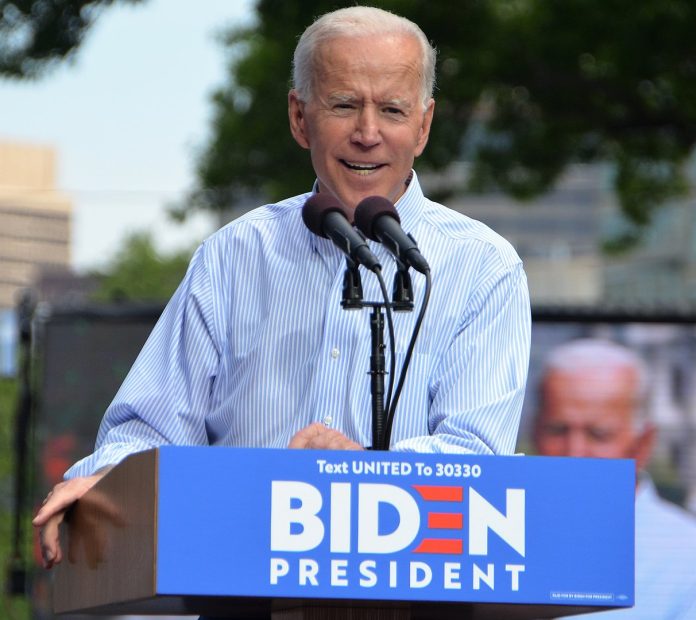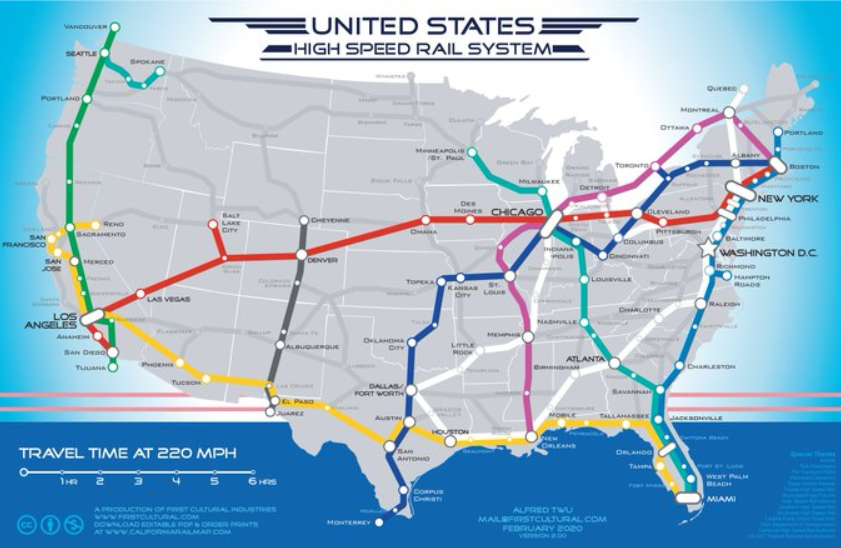
President Joe Biden released his much anticipated $2.25 trillion dollar jobs and infrastructure plan today. Republican congressional leaders were quick to brand it as an overly large grab bag of progressive priorities, saying that like it was a bad thing. The breath of investments is a strength, but it also means transit and housing investments fall short of what many progressive advocates were seeking.
Two million affordable homes
The plan dedicates $300 billion to social housing aiming to preserve or create two million affordable homes. This works out to $150,000 per unit, suggesting local government and nonprofit matching funds will be needed to hit the target. Some Democratic housing plans have proposed far higher production goals, led by Representative Ilhan Omar’s Homes For All bill seeking to generate 12 million social housing units.
The Covid pandemic has added a tremendous strain on an already strained housing system. Millions of Americans are out of work and relying on eviction moratoriums to stay housed. A rent relief plan to keep folks with back rent from getting evicted alone could be quite expensive. The Biden administration seemed poised to begin investing in public housing once more after four decades of neglect. However, to catch up for those years of disinvestment and to set right the incredible housing injustice caused by centuries of racist housing policies, a large program may be needed.
One positive sign is that President Biden intends to connect the spending to commitments from local governments to ease their apartment bans and anti-affordability zoning and land use restrictions. It will be interesting to see if that provision survives the legislative sausage-making, but it could be a boon to pro-housing advocates. It would build upon the Affirmatively Furthering Fair Housing policy President Obama enacted on his way out and Trump attacked and dismantled.
By the way, the plan is funded by repealing the Trump corporate tax cuts and seeking to target companies that park their profits in offshore accounts. The $2.25 trillion in investments is spread over eight to ten years. President Biden is promising a companion proposal, the American Families Plan, that would be focused on “social infrastructure” like universal pre-kindergarten, affordable child care, and healthcare reforms. That plan would spend another additional $2 trillion or so and details are expected a few weeks from now.
Amtrak Joe shifts into medium gear
The outlook on transit is a bit murky. The Biden administration said the package would double federal investment in transit and quadruple passenger rail investment — an unprecedented investment in Amtrak that would earn his “Amtrak Joe” moniker. However, since the transit program is mixed in a bucket with every other transportation priority from highways, airports, ports, and so forth, some advocates are worried that transit funding could get diluted and not stretch that far.
Moreover, the passenger rail figures — $80 billion for Amtrak’s repair backlog — aren’t large enough to guarantee a broad buildout of high-speed rail. Amtrak’s Northeast Corridor is signaled out for upgrades, but more ambitious plans to create a national network of truly high-speed rail would need far larger investments than what’s proposed, as would more regional plans to develop high-speed rail clusters, such as hubs around Chicago, Los Angeles, New York City, and Atlanta. Likewise, it’s not the kind of money that gets Cascadia high-speed rail, connecting Seattle north to Vancouver and south to Portland, off the ground. In comparison, Representative Seth Moulton (D-Massachusetts) high-speed rail bill calls for $205 billion in federal investment.

Instead, more incremental passenger rail improvements seem to be tabbed, which could also be hugely beneficial, but not necessarily as revolutionary in terms of enticing people out of planes and cars.
On the other hand, the focus on more incremental investments could unlock an era of bus rapid transit rollout that could have a big impact and jumpstart transit ridership in mid-sized and Sun Belt cities where transit share is still pretty anemic. In large cities, funding to backfill existing budgets and add bus rapid transit could help complement and stabilize subways and light rail plans even if this level of investment isn’t going to allow a major buildout of rail transit beyond existing plans. In the Seattle metropolitan area’s case, we’re helped by having an United States Senator who is a senior member of the Appropriations Committee; Senator Patty Murray is fighting to get Sound Transit an extra $1.9 billion to fill budget holes, Mike Lindblom reported. The Biden administration has said $85 billion should flow to transit for system modernization and expansion.
Notwithstanding increased transit investments, cars continue to be a significant area of investment, with $100 billion tabbed for electric vehicle charging infrastructure alone. The highway plan is branded “Fix It First” but the devil is in the details, and leading transportation experts have noted the bill doesn’t preclude the same old lurch into highway expansion that has undermined transportation packages of the past and ensured that America is the top climate polluter on the planet.
Safety and removal of racist freeways
Another positive sign is an acknowledgment of the safety crisis. “More than 35,000 people die in traffic crashes on U.S. roads each year, and millions more are seriously and often permanently injured,” the Biden plan fact sheet states. “The United States has one of the highest traffic fatality rates in the industrialized world, double the rate in Canada and quadruple that in Europe. Across cities, suburbs, and rural areas, President Biden’s plan will help parents get to work reliably and affordably, reduce the impacts of climate change for our kids, and make sure fewer families mourn the loss of a loved one to road crashes.”
Likewise, the plan acknowledges the negative health impact of busy highways and the racist legacy of plowing them through urban cores in the first place, most often through communities of color. The plan would invest $20 billion for rectifying those mistakes, potentially through freeway removal in some of the more egregious cases. In other cases, freeway lids to at least put park space and buildings atop gaping freeway trenches could qualify, as Lid I-5 Seattle highlighted.
“Too often, past transportation investments divided communities — like the Claiborne Expressway in New Orleans or I-81 in Syracuse — or it left out the people most in need of affordable transportation options,” the fact sheet states. “The President’s plan includes $20 billion for a new program that will reconnect neighborhoods cut off by historic investments and ensure new projects increase opportunity, advance racial equity and environmental justice, and promote affordable access.”
Unfortunately, Biden spokespeople have still conjured images of congestion relief to sell their plan, as pedestrian safety author, Angie Schmitt noted. Highway investments have a terrible track record of actually solving congestion, as we frequently write about.
Subsidizing electric car owners
On the other hand, the Biden administration seems to see itself in a race with China to win the electric vehicle market and produce more cars. Incentivizing car ownership will undoubtedly conflict with his goals around safety, transit, and ultimately climate, if subsidies don’t also help people afford transit, electric bikes, and housing in walkable neighborhoods, which are all demonstrated to have a much larger impact on shrinking carbon footprint than cars.
“U.S. market share of plug-in electric vehicle (EV) sales is only one-third the size of the Chinese EV market. The President believes that must change,” the fact sheet states. “He is proposing a $174 billion investment to win the EV market. His plan will enable automakers to spur domestic supply chains from raw materials to parts, retool factories to compete globally, and support American workers to make batteries and EVs. It will give consumers point of sale rebates and tax incentives to buy American-made EVs, while ensuring that these vehicles are affordable for all families and manufactured by workers with good jobs. It will establish grant and incentive programs for state and local governments and the private sector to build a national network of 500,000 EV chargers by 2030, while promoting strong labor, training, and installation standards.”
The generous electric car subsidies of the Obama administration have still left the national adoption rate for electric cars under 1%. Plug-in electric cars share of new car sales didn’t crack 1% in the last decaded even with that subsidy. Better electric cars and easier access to charging will increase adoption, but hanging America’s climate action hopes primarily on electric cars is a recipe for failure. Part of why: Car-centered urbanism still locks in sprawl and bad land use decisions. And as long as electric cars stay expensive, this subsidy will flow to the wealthy almost exclusively.
Broadband for all, but how expensive will it be?
Another welcome investment was $100 billion aimed at giving all Americans access to high-speed internet. Again, the initial reaction was a mixed bag. On hand it’s a worthy goal and a good sign that the Biden administration is signaling they won’t just funnel money toward corporations to make it happen, as has failed to deliver in the past. However, the plan doesn’t tackle the issue of the high cost of fast internet (or really any internet) in communities that do have access.
The Biden administration’s hands are somewhat tied since the courts have restricted the Executive’s ability to overrule state restrictions after Obama gave it a go. Still Biden promises to help local and municipal broadband efforts that looked to compete with the monopolies and duopolies run by the Comcasts, Verizons, and AT&Ts of the world.
“President Biden’s plan will promote price transparency and competition among internet providers, including by lifting barriers that prevent municipally-owned or affiliated providers and rural electric co-ops from competing on an even playing field with private providers, and requiring internet providers to clearly disclose the prices they charge,” the plan states.
“The problem: neither the Biden FCC nor broader administration can do much about such state-level restrictions. Previous efforts by the Obama FCC to eliminate state barriers to community broadband were shot down in court,” Karl Bode reported in Vice. “Still, clear support for such efforts is a course change from the GOP, which has repeatedly tried to ban community broadband entirely.”
Internet and cable providers led by Comcast (which famously claimed its political contributions were so great, it would be too much of a burden to disclose them all) invest an ungodly sum in political campaigns, ensuring they have the ear of lawmakers if not the votes outright. The result is high cost internet and low-quality customer service.
“Consumer groups argue that when it comes to U.S. broadband, the problem isn’t just access, but cost,” Bode continued. “Due to limited competition, Americans pay some of the highest prices for broadband in the developed world, most recently showcased by toddlers in Silicon Valley having to huddle around fast food restaurants simply to attend class during COVID lockdowns.”
It remains to seen whether President Biden can crack the code and outmaneuver the powerful internet monopolies to provide universal broadband access and drive down costs. But it’s refreshing to see a president suiting up for the battle.
Update: This article was updated at 4:10pm to add mention of freeway lids and of Rep. Moulton’s high-speed rail bill.
Doug Trumm is publisher of The Urbanist. An Urbanist writer since 2015, he dreams of pedestrian streets, bus lanes, and a mass-timber building spree to end our housing crisis. He graduated from the Evans School of Public Policy and Governance at the University of Washington in 2019. He lives in Seattle's Fremont neighborhood and loves to explore the city by foot and by bike.


